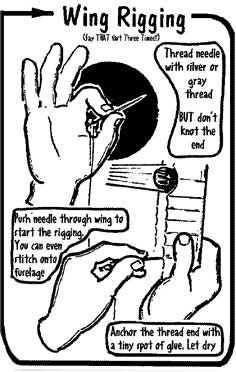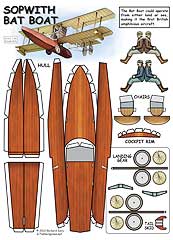
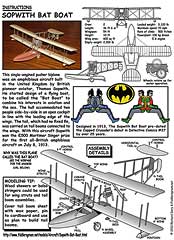
Sopwith-Bat-Boat - $$6.50
The Bat-Boat II was the very first flying boat to have a ventilated step. The Admiralty aircraft was later sold to Greece. Strangely Sopwith built another Mk,II and sold it to Germany just before the outbreak of World War One. Later Sopwith designed a version as a gun ship but it was never built. WHY was it called the Bat Boat?? You'll never guess. Just know it had nuthin' to do with Bat Man & whats his name.
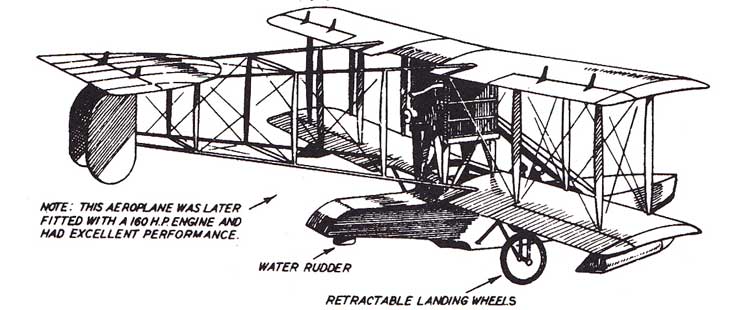
Sopwith-Bat-Boat
INCREDIBLE!! :D Love it, love it, love it!!!
But does one fly it, or FLOAT it! Or both......neither??? That would look great in our bathroom, and could handily double up as a soap dish..Derek
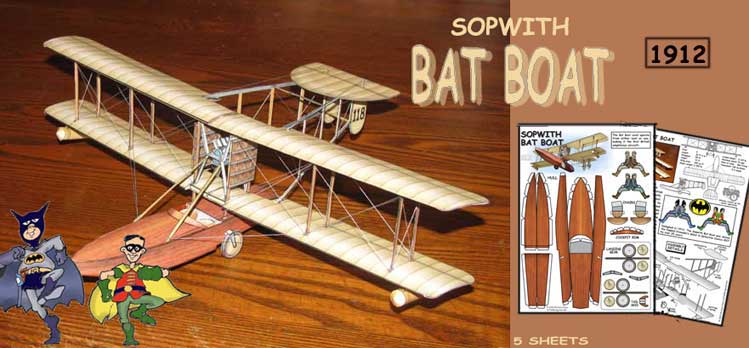 The Bat-Boat II was the very first flying boat to have a ventilated step. The Admiralty aircraft was later sold to Greece. Strangely Sopwith built another MkII and sold it to Germany just before the outbreak of World War One. Later Sopwith designed a version as a gun ship but it was never built.
The Bat-Boat II was the very first flying boat to have a ventilated step. The Admiralty aircraft was later sold to Greece. Strangely Sopwith built another MkII and sold it to Germany just before the outbreak of World War One. Later Sopwith designed a version as a gun ship but it was never built.
The Sopwith Bat-Boat entered service with the Naval Wing of the Royal Flying Corps in 1913, just before the Admiralty re designated it as the Royal Naval Air Service, primarily as a patrol craft for the Fleet. Less than half a dozen were built and all varied in design detail, engine type and size and span of the wings. The type was progressively modified including one aircraft being adapted to become amphibious in order to compete in the Mortimer-Singer competition for a series of land and water-borne take off and landings, which it won. This resulted in the German Navy actually buying an example.
The "Round Britain" Machines. (from a 1914 issue of 'Flight' Magazine)
The machine which was officially numbered 3 for the Circuit of Britain race was the Sopwith Bat Boat, to have been piloted by Mr. Pixton. In its general layout this machine is very
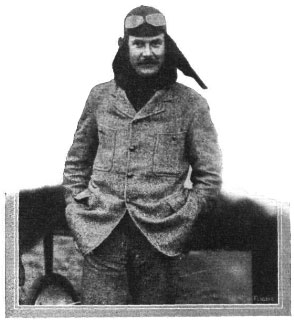 |
Mr C. Howard Pixton, the pilot who was nominated for the Sopwith Bat Boat in the Round Britain Race |
similar to the seaplane which was the object of so much admiration at the last Aero Show at Olympia. Several alterations have, however been effected, as, for instance, the substitution of as 200 h.p. Sunbeam engine for the Slamson Canton-Unne with which the show machine was fitted.
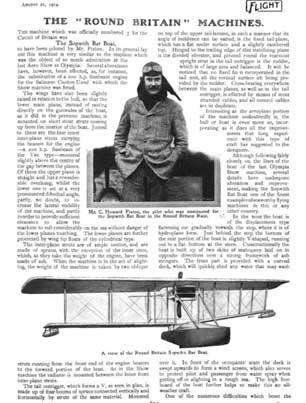 The wings have also been slightly raised in relation to the hull, so that the lower main plane, instead of resting directly on the gunwales of the boat, as it did in the previous machine, it is mounted on short struts.
The wings have also been slightly raised in relation to the hull, so that the lower main plane, instead of resting directly on the gunwales of the boat, as it did in the previous machine, it is mounted on short struts.
coming up from the interior of the boat. Joined to these are are the four inner inter-plane struts carrying the bearers of the engine- a 200h.p. Sunbeam of the Vee type- mounted slightly above the centre of the gap between the planes. Of these, the upper plane is straight and has a considerable overhang, whilst the lower one is set at a very pronounced dihedral angle, partly, no doubt, to increase the lateral stability of the machine, and partly in order to provide sufficient clearance to allow the machine to roll considerably in the sea without danger of the lower planes touching. The lower planes are further protected by wing tip floats of the cylindrical type.
The interplane struts are of ample section, and are made of spruce, with the exception of the inner ones which, as they take the weight of the engine, have been made of ash. When the machine is in the act of alighting, the eight of the machine is taken by two oblique struts running from the front end of the engine bearers to the forward portion of the boat. As in the Show machine the radiator is mounted between the inner front inter-plane struts.
The tail outrigger, which forms a V, as seen in plan, is made up of four booms of spruce connected vertically and horizontally by struts of the same material. Mounted on top[of the upper tail booms, in such a manner that its angle on incidence can be varied, is the fixed tail plane, which has a flat undersurface and a slightly cambered top.
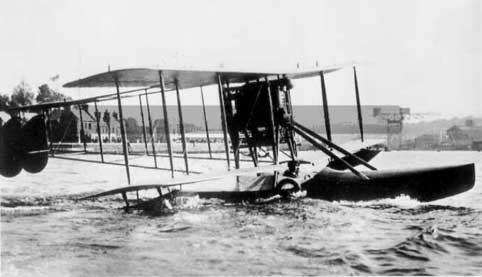 Hinged to the trailing edge of the stabilizing plane is the divided elevator, and pivoted round the rearmost upright strut in the outrigger is the rudder, which is of large area and balanced. It will be noticed that no fixed fin is incorporated in the tail unit, all the vertical surface aft being provided by the rudder. Cross-bracing everywhere between the main planes, as well as in the tail outrigger, is effected by stout stranded cables, and all control cables are in duplicate.
Hinged to the trailing edge of the stabilizing plane is the divided elevator, and pivoted round the rearmost upright strut in the outrigger is the rudder, which is of large area and balanced. It will be noticed that no fixed fin is incorporated in the tail unit, all the vertical surface aft being provided by the rudder. Cross-bracing everywhere between the main planes, as well as in the tail outrigger, is effected by stout stranded cables, and all control cables are in duplicate.
Interesting as the aeroplane portion of the machine undoubtedly is, the hull or boat is even more so, incorporating as it does all the improvements that long experience with this type of craft has suggested to the designers.
Although following fairly closely on the lines of the boat of the last Olympia Show machine, several details have undergone alteration and improvement, making the Sopwith Bat Boat one of the finest examples of seaworthy flying machines in this or any other country.
In the nose, the boat is of the displacement type flattening out gradually towards the step, where it is of hydroplane form. Just behind the step the bottom of the rear portion of the boat is slightly V-shaped, running out to a flat bottom at the stern. Constitutionally the boat is built up of two skins of mahogany laid on the opposite directions over a strong framework of ash stringers. The front part is provided with a curved deck, which will quickly shed any water that may wash over it. In front of the occupants' seats the deck is swept upwards to form a wind screen, which also serves to protect pilot and passenger from water spray when getting off or enlighting in a rough sea . The high freeboard of the boat further helps to make this an all-weather craft.
One of the numerous difficulties which beset the designer of hulls or floats of the stepped type is that of admitting air to the step. In the Sopwith Bat Boat this difficulty has been overcome in a most ingenious way by fitting external channels or scoops screwed to the sides of the boat, thus doing away with thee necessity of piercing the bottom as in the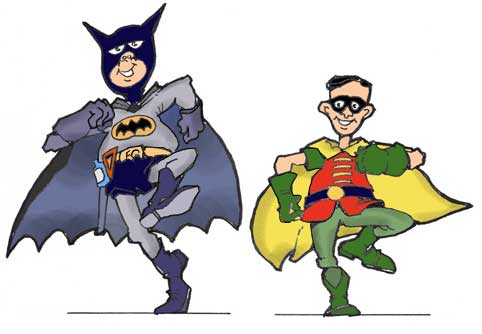 case of internal air tubes. As to the efficiency of this arrangement, one can only conclude that it has proved to answer its purpose, since after being tested in previous machines, it has been retained in this latest product of the Sopwith firm.
case of internal air tubes. As to the efficiency of this arrangement, one can only conclude that it has proved to answer its purpose, since after being tested in previous machines, it has been retained in this latest product of the Sopwith firm.
From the accompanying illustrations a good idea may be formed of the spacious accommodations for pilot and passenger, whose seats are arranged side by side inside the extremely roomy cockpit, the pilot occupying the right-hand seat. Ailerons and elevator are operates by means of a rotateable hand wheel mounted on a vertical tube which is free to move in a forward and backward direction. The rudder is actuated by a pivoted foot bar.
Large petrol and oil tanks, the capacity of which are 70 gals. and 7 gals. respectively, or enough for a flight of five hours duration with out replenishments, are fitted. The weight of the machine empty is 2,300 lbs, and with full load, including pilot and passenger, and fuel for 5 hours, the weight is 3,120 lbs. the total area is 600 square feet, the loading works out 5 lbs per sq ft. A speed range of from 48 m.p.h. and 75 m.p.h is anticipated, so that with five hours' fuel the radius of action is in the neighborhood of 180 miles. By fitting larger tanks it should be possible, if desired, to increase that figure considerably.
In the event of the Sopwith Bat Boat being, or having already been, taken over by the Admiralty, there is no doubt that she would not only prove to be an effective addition to our fleet of seaplanes, but that she would also add considerably to the high reputation of Sopwith Co.
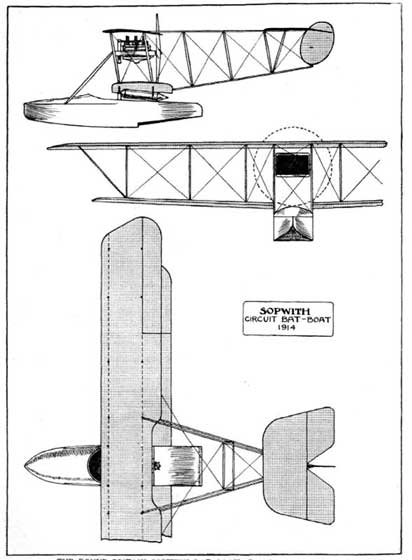 This is the Bat Boat talked about in the article above |
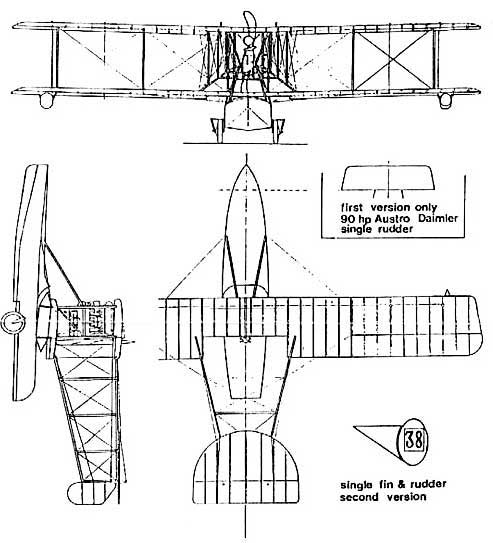 Sopwith Bat Boat three views .. . |
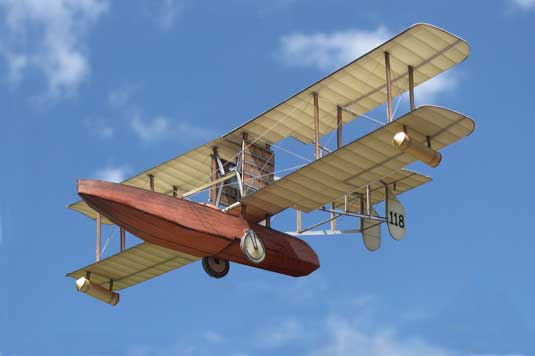 First beta build of the Sopwith Bat Boat by FG designer Richard Dery |
Lets talk a little about rigging... We, here at Fiddlersgreen usually photoshop in the rigging although all the photos on this page came from Richard Dery, the designer, and he HAS done the rigging properly. One of our builders, Bob Martin, has figured out that its easier to take a large paint brush and simply clip off the bristles as needed and glue them between the struts.
|
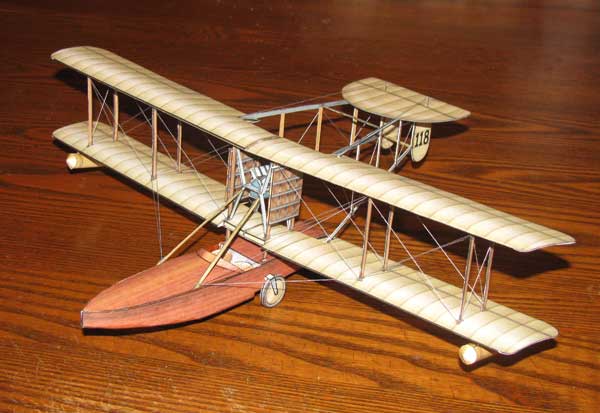 |
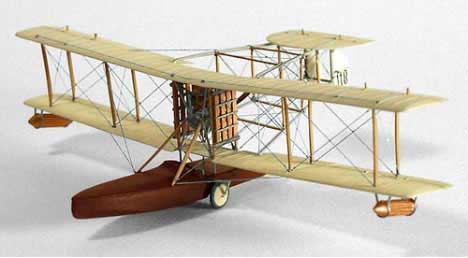 Wooden model of the Sopwith Bat Boat-not from Fiddlersgreen Wooden model of the Sopwith Bat Boat-not from Fiddlersgreen |
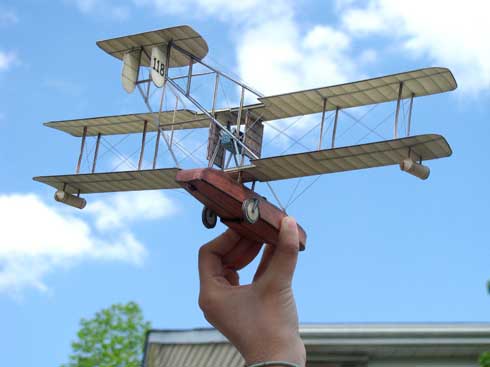 Richard's hand as he's setting up the photo-shoot |
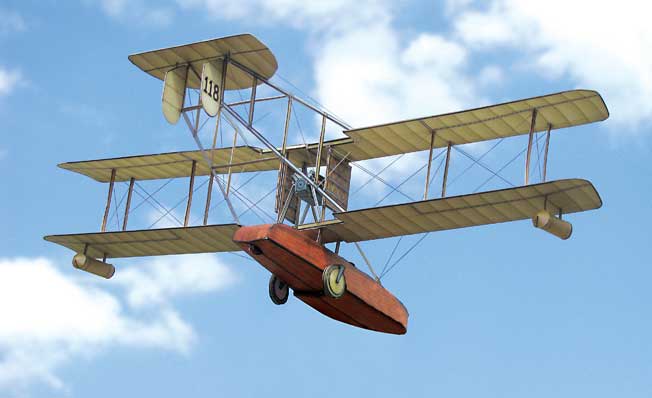 Bat Boat flying away without pilot or even a helping hand-see left |
Sooo.. why did they call this the 'Bat Boat'?
It was named after a scandalous flying machine in the short story named:'With the Night Mail' by Rudyard Kipling
Bat-Boat Racing
The scandals of the past few years have at last moved the yachting world to concerted action in regard to "bat" boat racing.
We have been treated to the spectacle of what are practically keeled racing-planes driven a clear five foot or more above the water, and only eased down to touch their so-called "native element" as they near the line. Judges and starters have been conveniently blind to this absurdity, but the public demonstration off St. Catherine's Light at the Autumn Regattas has borne ample, if tardy, fruit.
In future the "bat" is to be a boat, and the long-unheeded demand of the true sportsman for "no daylight under mid-keel in smooth water" is in a fair way to be conceded. The new rule severely restricts plane area and lift alike. The gas compartments are permitted both fore and aft, as in the old type, but the water-ballast central tank is rendered obligatory. These things work, if not for perfection, at least for the evolution of a sane and wholesome waterborne cruiser. The type of rudder is unaffected by the new rules, so we may expect to see the Long-Davidson make (the patent on which has just expired) come largely into use henceforward, though the strain on the sternpost in turning at speeds over forty miles an hour is admittedly very severe. But bat-boat racing has a great future before it.



